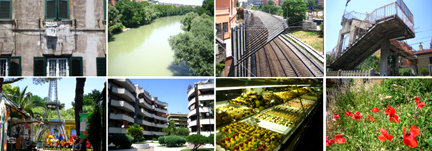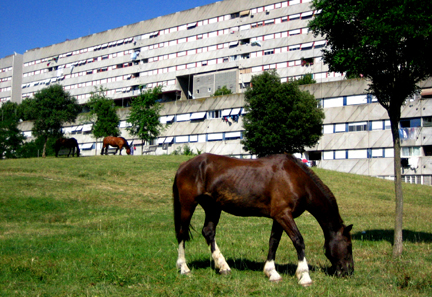Pilgrimage to Corviale
(From three weeks ago, undisciplined blogger that I am) Five days to unexpectedly fill in Rome…….so I decided to undertake my own exploratory walk. For a while I wondered whether to do a section of the Campagna Romana itinerary, but settled instead on a trip to Corviale, a kilometre long housing block built on the edge of the city in the sixties.
In the past couple of years Stalker have been involved in a multidisciplinary exploration of the use and appropriation of the public spaces in the building, as part of a research network called Osservatorio Nomade. Their work included the setting up of a ‘Corviale Network’ – a local television station involving residents which aimed to challenge media stereotypes about the building. The television station has been described as a public space in itself - “a positive instrument of exchange and information within and outside Corviale…. a flexible instrument that can be modulated according to the different needs of its shareholders”. The project has been covered extensively in the press, perhaps less for the clarity of the outcome than the photogenic allure of the research subject itself. I was able to find it on a large map of Rome immediately - a curious long skinny line right at the edge, bearing no resemblance to any other marks on the page at all.
My walking companion was an American, a graduate student in music who appeared to have found Rome a more inspiring place to compose than Miami. Our plan confused a number of our fellow hostellers who were swapping their intentions for the day over breakfast - “today I’m going to do the Colosseum, yesterday I did the Trevi Fountain…”. And I hoped that it might act as a mild resistance to the mindset of one girl who informed me that “you can do Venice in four hours….all there is to see really is San Marco”.

We began our walk at the site of one of Stalker’s other projects, an old slaughterhouse inhabited by Roma Gypsy and Kurdish communities. From there we walked through old, densely-populated housing districts with washing hanging from windows and the usual tangle of television aerials, across the river and past the Travestere railway station. A lonely little pedestrian bridge took us over the rail tracks into gradually more suburban areas not without their intrigues, including a miniature Eiffel Tower. After a couple of hours the countryside began to actively penetrate the city with sudden swathes of wildflowers and handsome country villas perched on the edge of hillsides, peering down at the intruding suburbs. As we walked we compared disciplines of music and architecture and I recognised the same grandiose ambitions of a fellow thesis student – his baby a 25 minute digital piece that apparently chronicles the entire development of Western music!

Finally we rounded a corner and saw Corviale running endlessly across the brow of a distant hill. For some reason I felt like a bizarre kind of ill-defined pilgrim. We walked the length of it and it really was like an encounter with a mindset from another era. I noticed the fourth floor, the fate of which has been well documented in the magazines. Originally intended for community facilities which were never delivered, it is now filled in with concrete blocks and irregular window systems as people built in their own illegal apartments. I wondered if we would seem suspicious, but somehow a linear building of 6000 inhabitants lacks the intimacy for people to claim the space around it as theirs to distinguish between legitimate visitors and unwelcome intruders.
And beyond the building you look onto rolling hills and horses grazing in the field in front of it, a truly abrupt marking of the edge of the city. Not a petrol station or small housing development in sight!

The following night I went to the book opening of “Immaginare Corviale” at the Olivetti Foundation, the sponsors of the project. Sociologists and cultural commentators talking eloquently (I presume since it was all in Italian!) from a rooftop next to the Piazza Navona. The concrete edifice seemed a world away from the splendid views over the ancient heart of the capital and the dozens of impeccably dressed Italians attending the event; perhaps an inevitable contradiction of any social project funded with grants from elite cultural institutions.


» Post a Comment